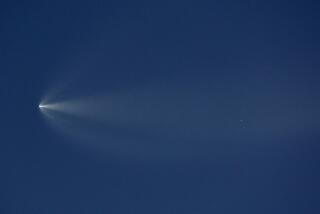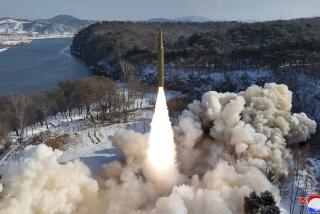Successful U.S. A-Test Ends Three-Month Lull : Respite Was Longest in Two Decades; Soviets Denounce Nevada Blast as âMilitaristic Actionâ
WASHINGTON â The United States set off its first underground nuclear test in three months at the Nevada test site Saturday, in what the Reagan Administration called a continuing effort to ensure the âcredibility and effectiveness of the U.S. nuclear deterrent.â
The test was immediately denounced as a âmilitaristic actionâ by Tass, the Soviet news agency. The Kremlin has been observing a self-imposed moratorium on nuclear explosions since July 30 and had offered to refrain from new tests as long as the United States did.
A group of 63 congressmen, mostly Democrats, had called on President Reagan on Friday to cancel the test, and there were moves in both houses to bar funds for U.S. tests as long as the Soviets maintained their moratorium.
Seismic Waves
Saturdayâs explosion, code-named Glencoe, went off without incident at 8:15 a.m., 2,000 feet under the Yucca Flat test site, the Energy Department announced. It raised a dust cloud at the site and set off seismic waves that registered 5.3 on the Richter scale at the National Earthquake Information Center in Golden, Colo.
The blast had a predicted force equal to between 20 and 150 kilotons. A kiloton is the explosive force of 1,000 tons of TNT. In comparison, the atomic bomb that devastated Hiroshima in 1945 released about 15 kilotons of energy.
It was the first U.S. test in nearly three months, and ended the longest respite in nuclear testing by the superpowers in more than two decades.
âThere werenât any real problems, everything went as planned,â Energy Department spokesman Jim Boyer said. Presumably this meant that no radioactivity escaped and that the explosionâs precise yield was not greater than 150 kilotons, in keeping with the U.S.-Soviet agreements barring underground tests above that size.
Although the Soviet Union had offered to extend its unilateral ban on nuclear testing, U.S. officials have complained that the beginning of its moratorium last July came after Soviet scientists had completed a series of test shots.
Reagan has repeatedly rejected the Soviet proposals for a pause in testing on grounds that such a ban cannot be effectively verified and that tests are required to guarantee the reliability and safety of nuclear weapons in the U.S. arsenal.
Despite its moratorium on actual testing, Soviet preparations for resumed testing are sufficiently advanced, U.S. officials said, to permit an explosion within a week or two.
The Tass statement, while remaining silent on Soviet intentions following the U.S. test, complained that âthe Reagan Administrationâs new militaristic action was carried out despite the wave of indignation in the United States, including in Congress, started by the very announcement of the test.â
About 70 protesters appeared at the boundaries of the desert test area, and eight were arrested for trespassing on test site property, which is protected by an elaborate system of ground sensors and is patrolled by armed guards in off-road vehicles. About 30 of the demonstrators reportedly came from the Great Peace March encampment in Barstow, Calif., about 250 miles away.
In justifying the resumed testing, State Department spokesman Pete Martinez read a prepared statement that said âthe test complies fully with existing agreements on nuclear testing limitations.â
The Saturday shot is part of a program to ensure weapons credibility and effectiveness, it continued. âNuclear weapons will remain for the foreseeable future the key element of our deterrent . . . .
âIn such a situation, where both the U.S. and our allies must rely upon nuclear weapons to deter aggression, nuclear testing will be required,â it added. âUnder existing conditions, neither a moratorium nor a comprehensive test ban would enhance the cause of security, stability or peace.â
The United States has not ratified either the Threshold Test Ban or the Peaceful Nuclear Explosions agreements, which restrict underground shots to 150 kilotons, although its representatives have signed both.
The Administration contends the Soviets have âprobablyâ violated the 150-kiloton limit. The Soviets deny the charge and U.S. arms control champions dispute the evidence in view of the lack of detailed geological knowledge of Soviet test sites.
The Administration has proposed that each nation allow on-site measurements of the seismic features of the other side in order to better calibrate distant instruments that measure the strength of underground tests. With such data, the Administration said it would submit the agreements to Congress for ratification.
More to Read
Sign up for Essential California
The most important California stories and recommendations in your inbox every morning.
You may occasionally receive promotional content from the Los Angeles Times.










